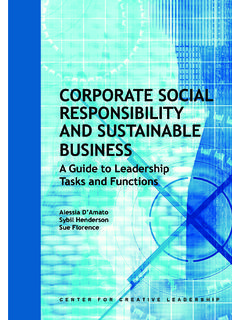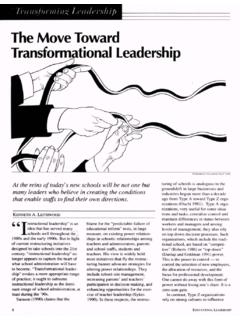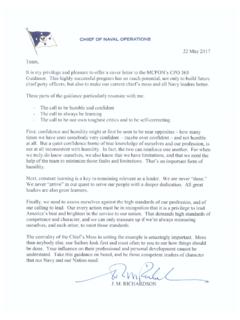Transcription of Making Leadership Happen - Leadership …
1 WHITE PAPERM aking Leadership HappenBy: Cynthia McCauleyThe ideas expressed in this paper represent the collective work of many colleagues at the Center for Creative Whole System Approach to Leadership 1 When Leadership Is Happening: Multiple People, Multiple Processes 2 The Manager s Role in Making Leadership Happen 7 About the Author 9 2014 Center for Creative Leadership . All rights reserved. 1A Whole System Approach to LeadershipMore than ever, in a fast-changing and interconnected world, organizations feel the need for Leadership . As a result, managers get a lot of advice on how to be more effective leaders. Articulate a clear vision, engage your employees, develop talent, have a global mindset, think strategically, create win-win solutions, leverage diversity, communicate effectively, hold people accountable, be an agile learner. On one level, all of this advice makes great sense. Who could argue with it? At another level, it can be overwhelming.
2 First, the lists of leader characteristics and behaviors seem endless. It s as if we ve taken every positive human quality and made it into a requirement for effective leaders. Second, some of the advice can seem contradictory at times. Managers are told to take charge and to empower others, to be politically savvy and authentic, to be flexible and the Center for Creative Leadership (CCL ), we think it s time to step back and take a different approach. Instead of putting the entire weight of Leadership on individual managers and their capabilities, we think it s important to examine how the whole system is involved in Making Leadership Happen . For example, the exchanges between employees and their managers, the interactions among peer managers or team members, the quality of relation-ships throughout the organization, the actions of teams and committees, and the use of existing organizational structures and processes all of these aspects of an organization can impact whether Leadership happens or not.
3 Don t get us wrong. We aren t abandoning the im-portance of individual managers examining and further developing their talents and capabilities. Rather, we re suggesting that such an exercise is necessary but not suf-ficient for improving Leadership in groups, organizations, and do we mean when we say Making Leadership hap-pen? First, in our whole system perspective, Leadership happens in the interactions and exchanges among people with shared work. Leadership can be happening within teams, workgroups, task forces, divisions, communities, and whole organizations. Leadership can be happening across teams, levels, and functions. (You ll find me using the word collective as a generic term for all the differ-ent forms that groups of people might take.) Regardless of the collective, for Leadership to Happen , the interac-tions and exchanges among people have to yield: Agreement on what the collective is trying to achieve together (Direction) Effective coordination and integration of the different aspects of the work so that it fits together in service of the shared direction (Alignment) People who are Making the success of the collective (not just their individual success) a personal priority (Commitment)These three outcomes direction, alignment, and com-mitment (DAC for short) make it possible for individuals to work together willingly and effectively to realize col-lective achievements.
4 So when we say Making Leadership Happen , we mean Making direction, alignment, and com-mitment Happen . In fact, we think the only way to know if Leadership has happened is to look for the presence of these three 2014 Center for Creative Leadership . All rights are many different ways that Leadership hap-pens. Sometimes a single individual plays a major role in Making it Happen . Sometimes it simply emerges in the conversations and interactions among people working together. Sometimes differ-ent people play different roles to bring it about. Both formal and informal processes can make it Happen . What brings about DAC in one situation may not bring it about in another situation. There are no easy formulas. Before looking at some examples of how Leadership happens, it is important to note that realizing col-lective achievements requires more than individuals working together willingly and effectively. Think of R&D teams creating a new product, sales groups reaching revenue targets, organizations producing goods and services, a school increasing its gradua-tion rates, a community creating a more sustainable environment.
5 Although Leadership is essential for such accomplishments, achieving these results is also dependent on other factors such as financial resources, people with the right technical knowledge and skills, appropriate technology, and effective business practices. Sometimes we can put too much emphasis on Leadership , forgetting that it is only one ingredient in the recipe for organizational senior management team of a hospital (one that is part of a large healthcare organization) talked in meetings over several weeks about the hospital s recent results on a standard set of quality of care metrics (hospital performance measures that are made available to the public by the government). Their performance was a bit above average enough to keep them in the good graces of headquarter executives but what should their goals be going forward? After much discus-sion, they unanimously agreed that they should set their goals higher than the goals given to them by headquarters.
6 Two factors seemed to figure into their decision. First, in recent years they had been working to re-establish their reputation in the local community. They felt that overachieving was a way to get the attention of people in the community. Second, they had a bit of a chip on their shoulder when it came to the healthcare organization. Being one of the organization s smaller hospitals, they sometimes felt overlooked. This was an opportu-nity to show what they could do. Raising a hospital s scores on quality metrics takes the concerted effort of the entire staff. So the man-agement team took their vision out into the orga-nization. They held formal meetings to share the goals and to explain why they thought it was im-portant to set the bar high and why they thought the hospital was up to the challenge. In the meet-ings, they first gauged the level of enthusiasm for taking on these lofty goals and found that the hospital staff was enthusiastic.
7 The staff clearly took pride in their work and wanted to be part of an organization known for its high-quality care of patients. During the meetings, staff members were also asked to generate strategies for reaching the goals. These ideas were brought back to senior team meetings and assigned to the appropriate individual or department to explore further. Special efforts were made to engage the medical staff a group essential to the hospital s success but not employed by the hospital. Believing that doctors are most influenced by other doctors, the hospital CEO first enlisted the help of a small group of phy-sicians whom he knew would be eager to support As already noted, Leadership happens in different ways. Consider the following scenario:When Leadership Is Happening: Multiple People, Multiple Processes 2014 Center for Creative Leadership . All rights reserved. 3the initiative, and this group became ambassadors to the medical community.
8 The eventual result of all the meetings, conversations, suggestions, and ex-plorations was a detailed two-year plan for increas-ing quality of patient care at the hospital. The plan involved every department and unit in the practices were put into place to keep the initia-tive moving in the right direction. First, all manag-ers were expected to schedule time each week to get out among staff and keep the initiative visible: they looked for evidence of plan execution, asked about successes and problems encountered, and reinforced the importance of the initiative. The VP of Nursing was particularly vigilant with her qual-ity rounds and served as a role model for others. Second, an oversight committee was established. A group of 25 managers and physicians met regularly to track progress, make adjustments, and vet new ideas. A strong sense of accountability developed within the group as they saw how strongly each member believed in the importance of what they were trying to achieve as an resulT: Two years later, an independent orga-nization listed the hospital s quality of patient care as tenth best in the nation.
9 Employee satisfaction was in the 95th percentile and physician satisfaction was in the 94th percentile Leadership is happening in this scenario. There was a shared direction. People were coordinating their ef-forts in service of that direction. Commitment to the initiative was high. How was all this DAC created? Through many different interactions and exchanges. Some of the key ones are highlighted in the chart was direcTion creaTed? By joining in a movement that was already afoot in the healthcare field a movement to enhance the quality of patient care in hospitals. By customizing organizational goals in ways that met local needs and desires. By having organizational goals crafted through discussion and joint agreement at the top of the organization and then tested for acceptance through meetings with staff throughout the organization. By having those who already shared in the direction influence was alignmenT creaTed?
10 By involving many throughout the organization in crafting an implementation plan that specified department and unit responsibilities. By managers staying abreast of how implementation was going on the front lines and by employees keeping them abreast. Through a coordinating committee that monitored progress and made was commiTmenT creaTed? By connecting the improvement initiative to the existing motivations of individuals ( , to achieve beyond what others expected, to deliver high-quality patient care). By drawing attention to and reinforcing goal-directed effort. Through a contagious effect: seeing others commitment increases one s own PaTienT care 4 2014 Center for Creative Leadership . All rights CEO of a midsize European company called three of her direct reports to a meeting: the VP of Human Resources, the VP of Organization Learn-ing and Development, and the VP of Strategy. What she shared came as a surprise to each of them.

















